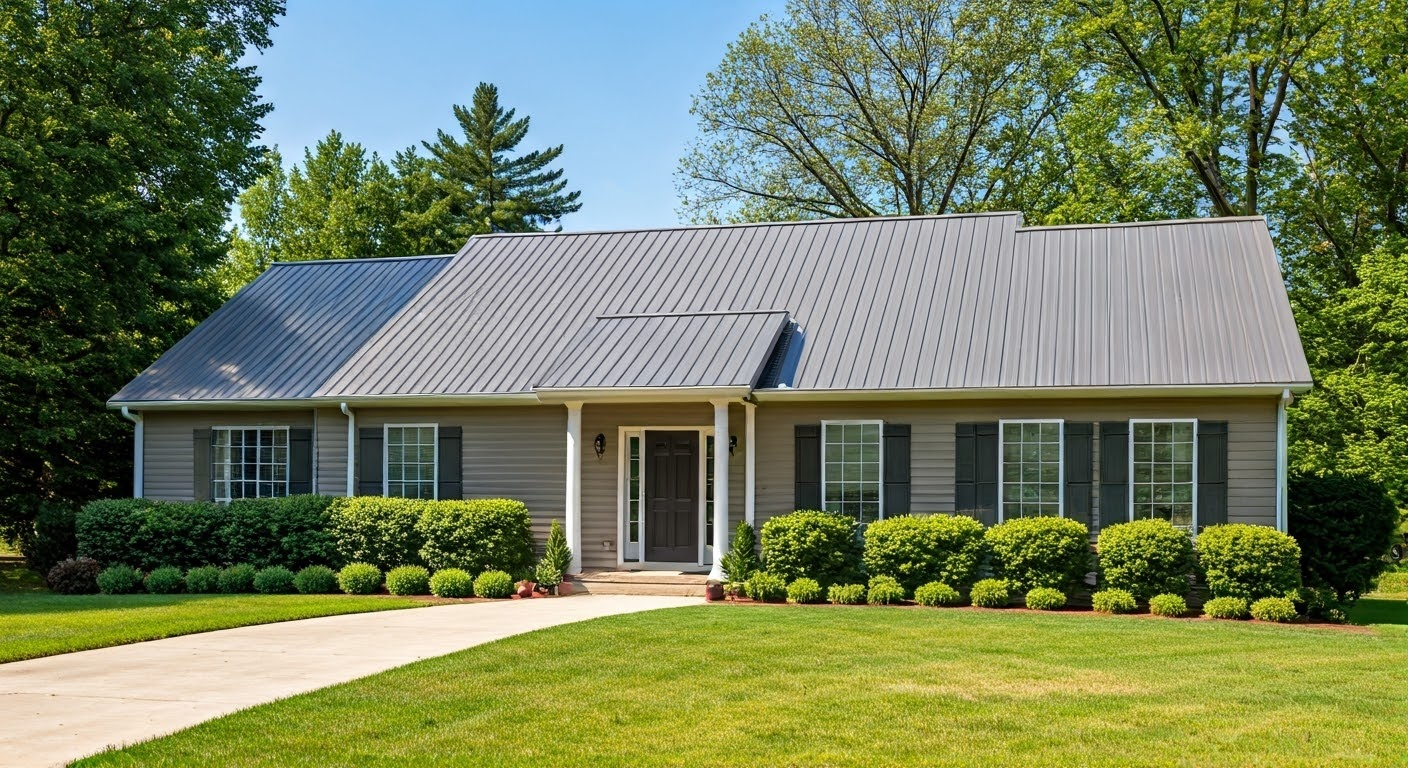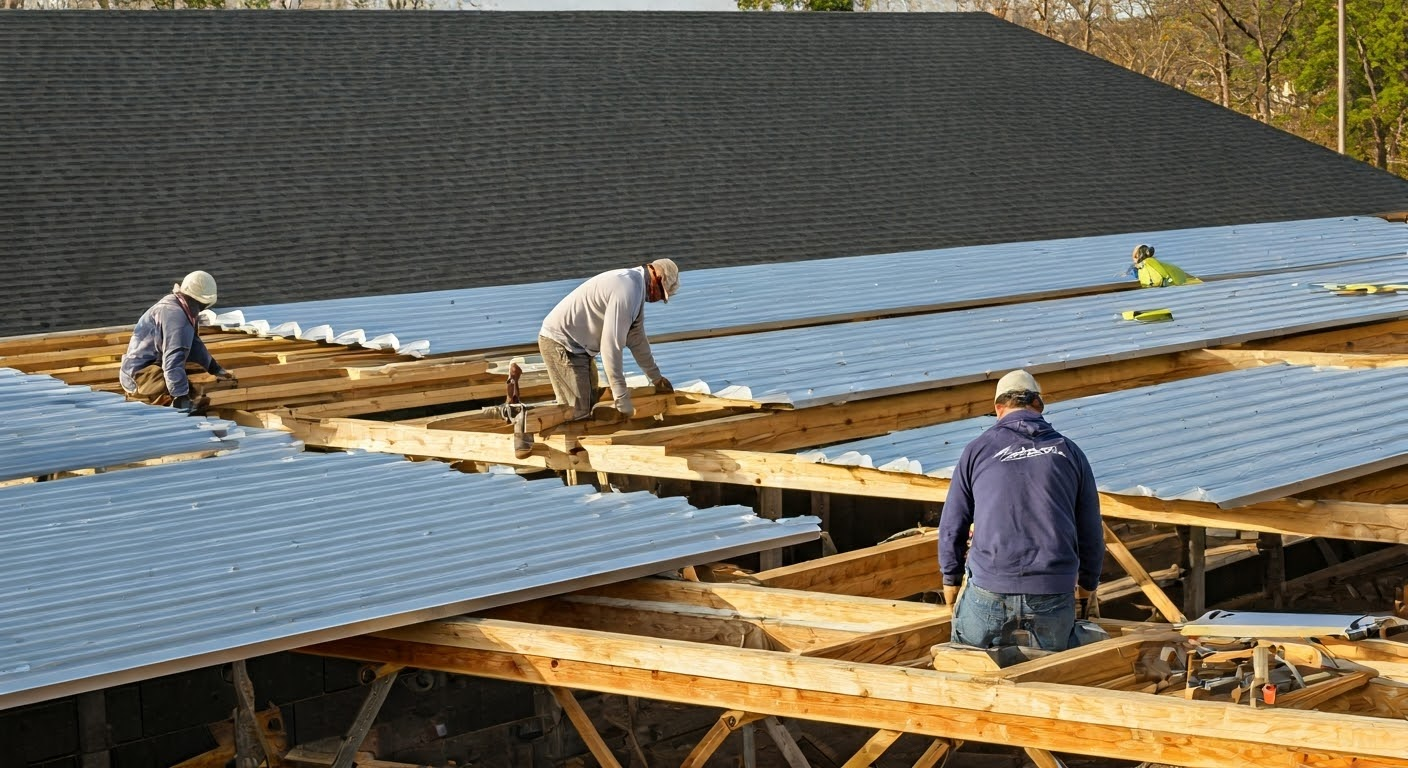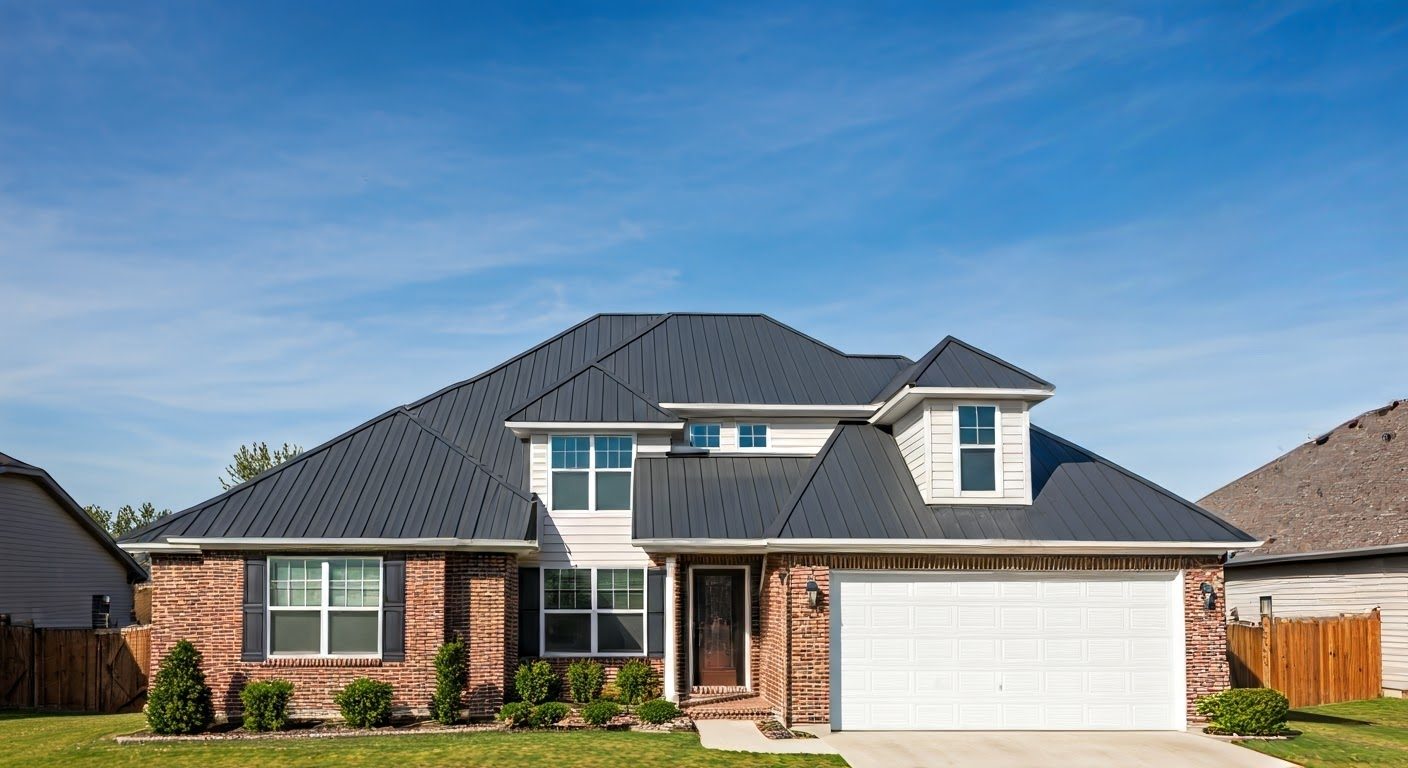
Key Highlights
- Metal roofing gauge determines the thickness and durability of metal roofing panels.
- 24 gauge is thicker, heavier, and pricier than 26 gauge, making it ideal for harsh climates.
- 26 gauge is lighter, cost-effective, and better suited for mild weather conditions.
- Factors like paint system, panel type, and installation complexity influence the cost of metal roofing.
- Heavier panels tend to last longer and are less prone to issues like oil canning.
- Choosing the right gauge involves assessing climate, budget, and roofing requirements.
Introduction
Metal roofing has become an increasingly popular choice for homeowners due to its durability and sustainability. When it comes to deciding on a new metal roof, understanding the significance of gauge metal is crucial. The gauge directly relates to the thickness and performance of your roofing panels, impacting both cost and functionality. In this article, we’ll explore the differences between 24 gauge and 26 gauge metal roofing, their respective benefits, and the factors that influence their price to help you make the best choice for your roofing project.
Understanding Metal Gauge in Roofing

Metal gauge serves as a standardized measure of the thickness of metal used in roofing materials. The gauge number inversely corresponds to thickness—lower numbers denote thicker metal. Common gauges for roofing include 22, 24, 26, and 29. Among these, 24 and 26 gauges are widely used for residential applications due to their balance of durability and cost.
Knowing the gauge of a metal roof is essential, as it impacts not only the performance but also the lifespan of the roofing system. Thicker roofing panels, such as 24 gauge, offer increased durability and strength, making them suitable for harsh conditions. On the other hand, lighter panels, like 26 gauge, are more affordable and easier to handle, catering to areas with mild weather. Deciding the gauge ultimately depends on your climate, budget, and project requirements.
Definition and Importance of Metal Gauge
The gauge of the metal refers to its thickness, measured using a standardized system. Simply stated, as the gauge number increases, the thickness of the metal decreases, meaning a 24 gauge metal is thicker than 26 gauge. This difference plays a significant role in determining the durability and cost-effectiveness of the panels.
The type of metal roofing you choose affects the available gauge options. For instance, standing seam panels are often manufactured in 24 gauge due to their premium features and structural strength, while corrugated panels may offer flexibility with lighter options like 26 gauge.
Understanding the thickness of the metal is especially important because it influences the resistance to wear, tear, and damage in adverse conditions. Thinner panels may suffice for mild climates, but thicker options deliver enhanced performance for heavy snow, high winds, and hail-prone regions, ensuring long-term durability.
Comparing 24 Gauge vs. 26 Gauge Metal
When comparing the two gauges, 24 gauge stands out for being a thicker gauge, capable of withstanding extreme weather conditions, heavier snow loads, and higher winds. This thicker material also reduces oil canning and offers better resistance to dents and punctures from hail or debris.
In contrast, 26 gauge is considered a lighter gauge, making it easier to handle and install. While it is less expensive and works well in milder climates, it lacks the durability required for severe weather conditions, limiting its application in harsher environments.
The standard gauge balancing act involves assessing the pros and cons of each option. While the thicker 24 gauge brings superior strength and longevity, it comes with a higher price tag. Meanwhile, the lighter 26 gauge offers flexibility and affordability but may compromise durability in challenging conditions.
Factors Influencing Metal Roofing Costs

The cost of metal roofing depends on various factors, including the type of metal used, the paint system, and the gauge thickness. Thicker panels like 24 gauge incur a higher cost due to increased material and manufacturing expenses, while 26 gauge panels are more budget-friendly.
Additionally, the complexity of the installation and associated labor costs significantly impact the overall cost of the roof. Understanding these variables can help homeowners find the best value without compromising durability or functionality.
Material Costs for 24 and 26 Gauge
Metal roofing prices vary depending on panel type, finish, and gauge. A 24 gauge metal panel typically costs between $1.20 and $5.50 per square foot, depending on paint systems and finishes. Specialty finishes like PVDF tend to be pricier but offer greater longevity and color retention.
For those opting for 26 gauge panels, the cost usually ranges from $0.75 to $1.50 per square foot. SMP-painted panels, available in limited color options, provide a more affordable choice while maintaining durability in milder climates.
Ultimately, while thinner panels come at a lower cost, thicker 24 gauge panels justify their higher price by offering longer-term savings through greater resilience, reducing the need for premature repairs and replacements.
Installation Complexity and Labor Costs
The installation cost of metal roofing largely hinges on the panel gauge and roofing system. Thicker panels, like 24 gauge, often require additional labor time due to their weight and rigidity. Consequently, labor costs can increase for homeowners choosing these premium-quality panels.
Lighter panels, such as 26 gauge, are comparatively easier to handle, leading to lower installation costs. Contractors can complete projects faster with these panels, making them a cost-effective choice for residential and commercial buildings in mild climates.
Other factors influencing the overall cost of the roof include choosing standing seam or corrugated panels and finishes like PVDF or SMP. As heavier panels withstand harsh conditions better, the higher upfront costs often pay off in terms of durability and reduced maintenance expenses over time.
Benefits of 24 Gauge Metal Roofing

Opting for 24 gauge metal roofing means investing in exceptional durability and strength, ideal for climates with heavy snow and wind. The thicker material enhances resistance to oil canning and provides better protection against hail and debris, ensuring the long-term performance of your roof.
While 24 gauge panels come with a higher cost, their ability to endure challenging weather conditions and fewer repairs make them an economical choice in the long run. Additionally, premium paint systems like PVDF are typically reserved for these thicker panels.
Durability and Longevity
The standout feature of 24 gauge roofing is its durability. The thicker panels can withstand greater stress compared to lighter gauges, performing exceptionally well in areas prone to severe weather conditions. A 24 gauge roof offers increased resistance to denting and punctures, enhancing its longevity.
Over time, these panels maintain a higher degree of structural integrity, ensuring fewer repairs and replacements. Additionally, they are designed to handle heavier snow loads effortlessly, reducing the risks of damage during harsh winters.
Choosing 24 gauge for your roofing project may mean spending more upfront, but the enhanced performance of your roof and the long-term savings make this choice worth considering for homeowners in extreme climates.
Suitability for Harsh Weather Conditions
Harsh weather conditions call for roofing materials capable of enduring heavy snow, strong winds, and hail. 24 gauge metal roofing excels under these circumstances, offering greater resilience compared to thinner options.
Its robustness translates into superior impact resistance, minimizing the risks of dents and damage from debris during storms. Thicker panels also help prevent oil canning, which can compromise the aesthetics of your roof over time.
For regions regularly subjected to extreme climates, the strength and reliability of 24 gauge panels provide optimal protection. This makes them a wise investment for homeowners looking to weatherproof their properties effectively.
Benefits of 26 Gauge Metal Roofing
26 gauge metal roofing provides a cost-effective solution, particularly for people in mild climates seeking affordability without sacrificing performance. These lighter panels are easy to install and handle, reducing labor and installation costs.
They are an excellent choice for projects like agricultural buildings or commercial spaces that don’t face extreme weather. While less durable than 24 gauge panels, their versatility and lower price make them appealing for budget-conscious homeowners and those in regions with less demanding roofing needs.
Cost-Effectiveness and Affordability
Affordability is a significant advantage of 26 gauge metal roofing. These panels are lighter, translating to reduced material costs and simpler installation processes, which lower the overall expenses.
Cost-effectiveness makes this gauge suitable for residential homes in mild weather zones, as well as commercial and agricultural projects where durability isn’t a top priority. The SMP paint system offers additional savings while delivering decent color retention.
When roof replacement budgets are tight, choosing 26 gauge panels allows homeowners to prioritize immediate affordability while still gaining the standard benefits of metal roofing, such as fire resistance and corrosion prevention.
Flexibility and Easier Handling
Flexibility is another key feature of 26 gauge panels. The lighter gauge is easier to cut, manipulate, and install compared to thicker options, minimizing labor costs and project timelines.
This flexibility is beneficial for unique roofing designs requiring intricate panel configurations. The lighter weight also reduces stress during transport and storage, simplifying the logistics of roofing projects.
For DIY enthusiasts or small-scale installations, the easier handling of 26 gauge panels offers greater convenience without compromising essential qualities like fire resistance or protection against corrosion in mild climates.
Making the Right Choice for Your Home
Choosing between 24 and 26 gauge metal roofing depends on factors like your climate, budget, and long-term priorities. While 24 gauge offers unparalleled durability for extreme conditions, 26 gauge can be a practical and economical solution for mild weather.
Homeowners must assess factors like snow loads, wind risks, and hail frequency before finalizing their choice. Consider the type of panel and paint system preferences to align your roofing needs with your budget and aesthetic goals.
Ultimately, the best gauge is one that meets your specific requirements without overextending your budget. Careful planning and expert advice will ensure you make an informed decision for your new roof installation.
Considerations for Residential Use
Residential users should evaluate their local climate and roof design before choosing the gauge metal roofing. If heavy snow or strong winds are common, opting for 24 gauge panels ensures adequate load capacity and durability.
The roofing underlayment also plays a role in determining the suitability of each gauge. Solid substrates work well for either option, but spanning from support to support may require the thicker 24 gauge for strength.
Metal roofing panels must align with your home’s aesthetic, functionality, and resilience needs. Prioritizing durability versus affordability is key to determining the ideal gauge for your residential project.
Expert Recommendations from Metal Roof Mobile AL
Experts suggest prioritizing durability if you live in regions with harsh weather conditions. Mobile-based roofing specialists recommend using 24 gauge panels with PVDF paint systems for standing seam designs demanding longevity and performance.
For cost-conscious homeowners in mild climates, 26 gauge panels with SMP paint systems provide ample protection while reducing expenses. Experienced contractors consider factors like wind uplift and snow loads before making recommendations based on the roofing system and type of panel.
Consulting professionals ensures your decision aligns with both current roofing market conditions and long-term structural achievements. Local expertise offers invaluable insights into what works best for your specific area.
Conclusion
In conclusion, choosing between 24 and 26 gauge metal roofing is more than just a price comparison; it’s about considering the unique needs of your home and the specific environment it faces. While 24 gauge offers superior durability and resistance to harsh weather conditions, 26 gauge provides a cost-effective solution with flexibility and ease of installation. By weighing the benefits of each type and understanding the factors that influence metal roofing costs, you can make an informed decision that balances both budget and performance. If you’re still unsure or need personalized advice, feel free to reach out to our experts at Metal Roof Mobile AL for guidance tailored to your home’s requirements. Remember, investing in the right roofing material now can save you time and money in the long run.
Frequently Asked Questions
Why is gauge important in metal roofing?
Metal gauge indicates the thickness of the metal, which directly affects roofing durability. A thicker gauge like 24 provides greater resistance to snow, wind, and hail, while lighter gauges like 26 offer cost-effective solutions for mild climates. Choosing the gauge determines the performance of a gauge metal roof.
How much more does 24 gauge roofing cost compared to 26 gauge?
24 gauge roofing comes with a higher price tag since it is roughly 30% thicker than 26 gauge. Costs range from $1 to $5 per square foot for 24 gauge, compared to $0.75 to $1.50 per square foot for 26 gauge, depending on finishes and panels.
What are the long-term savings associated with 24 gauge compared to 26 gauge?
With thicker panels like 24 gauge, long-term savings are realized through reduced repairs and extended durability. Thicker panels withstand harsh conditions better, reducing maintenance expenses. Over time, the investment in thicker gauge roofing results in valuable cost savings.
